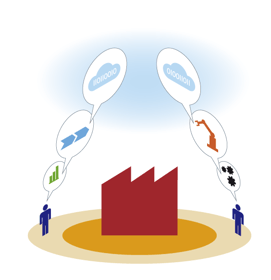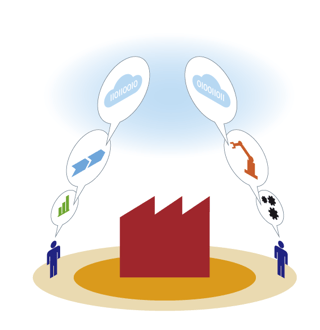The Evolution of Planning and Execution in Manufacturing
Nick Ostdick - August 10, 2017

 Think about the process of writing an email for a moment. How do you go about this task? Do you compose the email in one session without filtering what you want to say or the information you want to convey, only then to go back and reread and edit the email at some later date? Or (and perhaps mostly likely, at least for many people), do you compose the email and edit as you go, deleting phrases, substituting words, or changing ideas and adapting the information in the moment as necessary for the best possible communication?
Think about the process of writing an email for a moment. How do you go about this task? Do you compose the email in one session without filtering what you want to say or the information you want to convey, only then to go back and reread and edit the email at some later date? Or (and perhaps mostly likely, at least for many people), do you compose the email and edit as you go, deleting phrases, substituting words, or changing ideas and adapting the information in the moment as necessary for the best possible communication?
Odds are the most common method of emailing is the latter where edits and alterations are made in real-time as thoughts, ideas, and information hits you during the composing process. Where the first example may be a relic of the past when typewriters or handwritten correspondence was the norm, digital communication and the capacity to edit, rewrite, and revise in the moment means greater maneuverability in creating moments for effective, streamlined, and more productive communication. Where writing and editing/revising were at one time two distinct processes, today these functions are more or less integrated into one function with a greater level of process efficacy.
The same can be said for planning and execution in today’s manufacturing industry. 10 or 15 years ago planning and execution, much like writing and revising, were viewed as two distinct processes in global supply chain management. Flash forward to today and the evolution of technology and logistics thought-models and the integration of planning and execution in global manufacturing and supply logistics is part and parcel to managing an effective, efficient supply stream. Gone are the days when these two aspects of planning and production existed in silos, which created significant roadblocks for manufacturing companies relative to visibility, transparency, and agility.
However, in order to realize how planning and execution is integrating in today’s supply stream, you have to understand the history of these two elements, but also the potential of planning and execution in both the near and mid-term future.
Planning and execution: A brief history
In the last decade or so, huge advancements in optimized supply chain operations — plan for every part strategy, order slotting, sequencing, BOM explosion — have fueled a shift to more dynamic, interactive supply chain practices where planners and managers have greater control and visibility across a company’s entire supply stream. But many companies still engage in operations and demand planning as one stage of the supply process, then view execution as a crapshoot of this planning with little oversight into efficiency, allocation of resources, and cost-effectiveness.
As we discussed a moment ago, this also creates silos at each point in supply chain execution — order fulfillment, warehousing, and transportation — which results in very little monitoring of results, and measurements of performance are often completed far too late to have any real impact on a company’s supply network.
The consequences of this are reduced visibility and transparency, which can severely hamper a company’s ability to be agile and maneuver the complexities of today’s global supply chain management for example — a manufacturing company with facilities across the world can run into severe roadblocks in terms of coordination and communication by operating planning and execution in a vacuum. And this latency between planning and execution can also create a whole new set of complexities for companies weighing centralized or decentralized planning strategies — something we’ll touch on momentarily.
A contemporary take on planning and execution
To understand how the integration of planning and execution took hold in global supply chain management, let’s take the idea of plotting a road trip. You’re on the interstate and run into a severe traffic back-up due to unforeseen construction. You input this data into your GPS, which then creates an alternate route to save you time and money. This strategy, which is what we’ll call continuous planning, is how companies must view the intersection between planning and execution, and while this is obviously dependent on implementing the right software solutions with real-time reporting and adjustment capabilities, a fundamental shift in planning and execution philosophy is also required to embrace this new method of thinking.
Many companies currently address latency between planning and execution with re-planning or other strategies that require constant intervention — which is essentially the same as pulling over to the side of the road and consulting a map each time you encounter a disruption. Continuous planning, however, with assistance from networked systems, cloud-computing, and in-memory technologies is the only way to drive value and increase supply chain efficiency, especially in a more diverse, variant-rich supply stream with production and warehousing on a global scale.
Another factor to consider when merging planning and execution is the relationship between centralized and decentralized planning. Centralized planning, with a singular hub for all facilities to report, lacks the visibility and transparency we’ve discussed because facilities don’t have access or insight into how each one functions and the reporting thereof. On the other hand, a decentralized planning system operates each facility as a self-contained unit, and while there may be communication between these units, planning and execution across all units can be difficult because reporting and analysis is not filtered into one centralized location.
Where merging planning and execution into a continuing planning strategy comes into play is creating a bridge between these two systems of planning whereby each facility not only reports to a centralized location, but can also access key data that is crucial to driving production efficiency where delivery is met on-time in the specified quantities and conditions.
Planning and execution in the future
Given how far demand planning and execution have come during the last 10 to 15 years, it’s difficult to see where these concepts will go in the next 10 years, except to say the sky is the limit. Continuing advancements in technology and the proliferation of continuous planning strategy will significantly impact an industry that is becoming ever-more connected and diverse as new markets emerge and establish themselves. And companies who successfully reengineer their strategies to view planning and execution as a single action will be well-positioned to gain a competitive advantage in a very competitive industry.
LATEST POSTS
- Understand Circular Economy in The Manufacturing Industry
- How Can Industry 4.0 IT Integration Be Achieved Smoothly?
- The Significance of Order Sequencing in Discrete Manufacturing
- How to improve your Supply Chain Management: The Power of Control Towers
- Optimizing Human Resource Scheduling in Manufacturing: A Technological Approach



